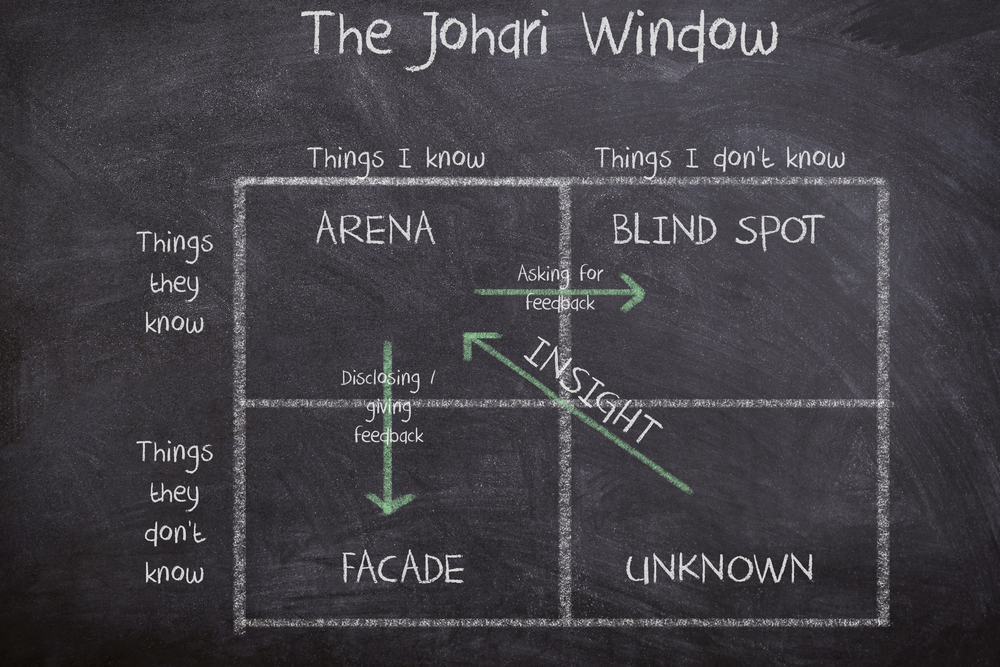The Universe can be difficult to navigate: as Paul Simon put it, “the nearer your destination, the more you’re slip slidin’ away.” The more you need a deal, in other words, the less likely you are to create or win a new opportunity. Your "need" can act as a sort of repellent, causing your prospective clients to move away from you like two magnets with the same polarity. When you have a need that is as great or greater than your prospective client’s need, it’s tough for a deal to come together.
The problem is that needing a deal can change your behavior in ways that prevent you from acquiring meetings, creating new opportunities, and winning new clients or new opportunities. By trying to meet your own needs, you can easily project that you are not focused on improving your prospective client's results—the only possible path to meeting your needs. You may not know how easy it is for your contacts to recognize a self-orientation.

The Johari Window
I believe that the Johari Window is the work of a person named Joe and another named Harry. In any case, it’s a 2x2 matrix, the kind that every consultant uses to teach something important (those who are unable to craft a 2x2 are not permitted to join the International Consultants Union, so this skill is critical). The quadrants of the Johari Window are as follows:
Lower Left: Things that are known to you and not known to others. (Hidden)
Upper Left: Things are known to you and also known to others. (Open)
Lower Right: Things that are not known to you and not known to others. (Unknown)
Upper Right: Things that are not known to you but are known to others. (Blind Spot)
When you have a need you are trying to meet, you might feel like your need is Hidden, known to you but not to others, but it's more likely for urgent needs to show up as a Blind Spot.

3 Behaviors that Project Self-Orientation
Certain sales behaviors project that your need may supersede your prospective client's need, a sure path to sabotaging your opportunity. There is a difference between being hungry (one of the very best attributes for a success-minded salesperson) and being starving (one of the very worst attributes, especially since salespeople only succeed by helping others improve their results).
A self-orientation is detrimental to your results. The more you focus on your goal, the more difficult it is to facilitate your client's buyer's journey. The more you try to meet your own needs, the more you are betrayed by the Johari Window. Here are three behaviors that prove you are pursuing your own needs.
The Need to Go Faster Than Your Prospective Client
The more you attempt to speed up the sales conversation, pushing for digital ink on your DocuSign contract, the more your client recognizes that the deal is about you and not them, their company, or their results. For them, it’s like going for a run with someone twice as fast: your need for speed will soon find you all alone, with your client disengaging after recognizing that they’re just a means to your end. Once this is seen and felt, your attempt to win your prospective business is over.
The Need to Talk and Avoiding Listening
Even though most salespeople know better, those in a hurry to win a deal will spend a lot of time talking, believing that info-dumps about their company and their solution will make it easier for a decision-maker to buy what they sell. The sales conversation is just that: a conversation. Rather than trying to talk your client into buying from you, you should be engaging with them to identify their target outcomes and discuss how best to meet them.
As someone who is capable of speaking for hours on a single breath, I am sensitive to this tendency. I had to learn to prefer listening to speaking. I also learned to lower my voice and my enthusiasm, practicing a patient, clinical approach to prove that the deal is not about my needs. One of the better practices in sales is waiting until people are finished with their part of the conversation before you speak.
The Need to Say I and We when Pursuing Deals
The more you say "I" and "we" or "our solution" and "our clients," the more you are expressing your need for a deal. There are a lot of people who will tell you never to pitch your client, but that’s just bad advice. A better way is to postpone your pitch until you’ve done the work necessary to deserve a “yes.” Most clients have a finely-tuned sense of fake or opportunistic pitches, especially if they’ve been bamboozled before.
Focusing exclusively on your client's needs will ensure that the conversation doesn’t focus on you and what you need. The only way to capture value is by first creating value. You win deals when you create value for the decision-makers, stakeholders, and contacts that are going to benefit from what you sell. By taking care of your client's needs, you increase your chances of winning their business.











